Nuragic civilization
The Nuragic civilization, born and developed in Sardinia, the second largest island in the Mediterranean Sea, lasted from the Bronze Age (18th century BC) to the 2nd century AD. The civilization's name derives from its most characteristic monument, the nuraghe, a tower-fortress type of construction built in numerous exemplars starting from about 1800 BC.[1] Today some 7,000 nuraghes[2] dot the Sardinian landscape.
No written records of this civilization have been discovered.[3] The only written information that we have comes from classical literature of the Greeks and Romans, and may be considered more mythological than historical.[4]
History
Pre-Nuragic Sardinia
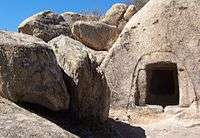
In the Stone Age the island was inhabited by people who had arrived there in the Paleolithic and Neolithic ages from several parts of Europe and the Mediterranean area.

The most ancient settlements have been discovered both in central Sardinia and Anglona. Later several cultures developed on the island, such as the Ozieri culture (3200−2700 BC).
The economy was based on agriculture, animal husbandry, fishing and trading with the mainland. With the diffusion of metallurgy, silver and copper objects and weapons also appeared on the island.
Remains from this period include hundreds of menhirs (called perdas fittas) [5] and dolmens, more than 2400 hypogeum tombs called domus de Janas, the statue menhirs, representing warriors or female figures, and the stepped pyramid of Monte d'Accoddi, near Sassari, which show some similarities with the monumental complex of Los Millares (Andalusia) and the later talaiots in the Balearic Islands. According to some scholars, the similarity between these structures and those found in Mesopotamia are due to cultural influxes coming from the Eastern Mediterranean.[6]
The altar of Monte d'Accoddi fell out of use starting from c. 2000 BC, when the Beaker culture, which at the time was widespread in almost all western Europe, appeared on the island. The beakers appeared in Sardinia from two different geographical areas: firstly from Spain and southern France and then from Central Europe, through the Italian Peninsula.[7]
Nuragic era

Early Bronze Age

The Bonnanaro culture was the last evolution of the Beaker culture in Sardinia (c. 1800-1600 BC), and displayed several similarities with the contemporary Polada culture of northern Italy. These two cultures shared common features in the material culture such as pottery with axe-shaped handles.[8] These influences may have spread to Sardinia via Corsica, where they absorbed new architectural techniques (such as cyclopean masonry) that were already widespread on the island.[9]
New peoples coming from the mainland arrived on the island at that time, bringing with them new cults, new technologies and new ways of life, making obsolete the previous ones or reinterpreting them.[10][11] The widespread diffusion of bronze brought numerous improvements to the tools used in agriculture, hunting and warfare.
From this period dates the construction of the so-called proto-nuraghe, a platformlike structure that marks the first phase of the Nuragic Age.
Middle and Late Bronze Age
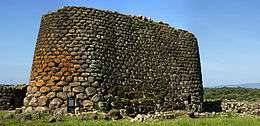
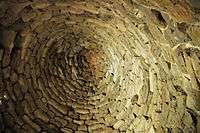
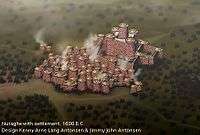
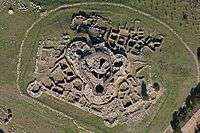
Dating to the middle of the 2nd millennium BC, the nuraghe, which evolved from the previous proto-nuraghe, are megalithic towers with a truncated cone shape; they are widespread in the whole of Sardinia, about one nuraghe every three square kilometers.[12] There has long been controversy among scholars. Theories about their utilization have included social, military, religious, astronomical role, as furnaces or sepulture places, but the modern agreement is that they were defensible homesites that included barns and silos.[13] In ancient times, Greek historians and geographers tried to solve the mystery of the nuraghe and their builders. They described the presence of fabulous edifices, called daidaleia, from the name of Daedalus, who, after building his labyrinth in Crete, would have moved to Sicily and then to Sardinia.[12]
In the second half of the 2nd millennium BC, archaeological studies have proved the increasing size of the settlements built around some of these structures, which were often located at the summit of hills. Perhaps for protection reasons, new towers were added to the original ones, connected by walls provided with slits forming a complex nuraghe.[14]
It has been suggested that some of the current Sardinian villages trace their origin directly from Nuragic ones, including perhaps those containing the root Nur-/Nor- in their name (like Nurachi, Nuraminis, Nurri, Nurallao, Noragugume[15]). Among the most famous of the numerous existing nuraghe, are the Su Nuraxi at Barumini, Santu Antine at Torralba, Nuraghe Losa at Abbasanta, Nuraghe Palmavera at Alghero, Nuraghe Genna Maria at Villanovaforru, Nuraghe Seruci at Gonnesa and Arrubiu at Orroli.
Soon Sardinia, a land rich in mines, notably copper and lead, saw the construction of numerous furnaces for the production of alloys which were traded across the Mediterranean basin and nuragic people became skilled metal workers; they were among the main metal producers in Europe [16] and with bronze they produced a wide variety of objects and new weapons as swords, daggers, axes, and after drills, pins, rings, bracelets, typical bronze statuettes, and the votive bronze boats that show a close relationship with the sea. Tin may have drawn Bronze Age traders from the Aegean where copper is available but tin for bronze-making is scarce;[17] The first verifiable smelting slag has come to light, its appearance in a hoard of ancient tin confirms local smelting as well as casting.[18] The usually cited tin sources and trade in ancient times are those in the Iberian Peninsula or from Cornwall. Markets included civilizations living in regions with poor metal resources, such as the Mycenaean civilization, Cyprus and Crete, as well as the Iberian peninsula, a fact that can explain the cultural similarities between them and the Nuraghe civilization and the presence in Nuragic sites of late Bronze Age Mycenaean, west and central Cretan and Cypriote ceramics, as well as locally made replicas, concentrated in half a dozen findspots that seem to have functioned as "gateway-communities.[19]
Sea people connection

_._Museo_archeologico_%22Villa_Abbas%22._Immagine_087.jpg)
The late Bronze Age (14th-13th-12th centuries BC) saw a vast migration of the so-called Sea Peoples, described in ancient Egyptian sources. They destroyed Mycenaean and Hittite sites and also attacked Egypt. According to Giovanni Ugas the Sherden, one of the most important tribes of the sea peoples, are to be identified with the Nuragic Sardinians.[20] Another hypothesis is that they arrived to the island around the 13th or 12th century after the failed invasion of Egypt. However, these theories remain controversial. Simonides of Ceos and Plutarch spoke of raids by Sardinians against the island of Crete, in the same period in which the Sea People invaded Egypt.[21][22] This would at least confirm that Nuragic Sardinians frequented the eastern Mediterranean Sea. Further proofs come from 13th-century Nuragic ceramics found at Tiryns, Kommos,[23] Kokkinokremnos [24] and in Sicily, at Lipari [25] and the Agrigento area, along the sea route linking western to eastern Mediterranean.

Recently the archaeologist Adam Zertal has proposed that the Harosheth Haggoyim of Israel, home of the biblical figure Sisera, is identifiable with the site of "El-Ahwat" and that it was a Nuragic site suggesting that he came from the people of the Sherden of Sardinia.[26]
Iron Age
Archaeologists define the nuragic phase as ranging from 900 BC to 500 BC (Iron Age) the season of the aristocracies. The handicraft produced fine ceramics and more and more elaborate tools, and the quality of the weapons increased.
With the flourish of the trade, metallurgy products and handcrafts were exported to every corner of the Mediterranean, from the Near East to Spain and the Atlantic. The huts in the villages increased in number and there was generally a large increase in population. The construction of the nuraghes stopped and individual tombs replaced collective burials (Giant's Tombs).[27][28]
But the real breakthrough of that period, according to archaeologist Giovanni Lilliu, was the political organization which revolved around the Parliament of the village, composed by the heads and the most influential people, who gathered to discuss the most important issues.
Carthaginian and Roman conquest
Around 900 BC the Phoenicians began visiting Sardinia with increasing frequency. The most common ports of call were Caralis, Nora, Bithia, Sulcis, Tharros, Bosa and Olbia.
The Roman historian Justin describes a Carthaginian expedition led by Malco in 540 BC against a still strongly Nuragic Sardinia. The expedition failed and this caused a political revolution in Carthage, from which Mago emerged. He launched another expedition against the island, in 509 BC, after the Sardinians attacked the Phoenicians' coastal cities. The Carthaginians, after a number of military campaigns in which Mago died and was replaced by his brother Hamilcar, overcame the Sardinians and conquered coastal Sardinia, the Iglesiente with its mines and the southern plains. The Nuragic civilization survived in the mountainous mainland of the island.
In 238 BC the Carthaginians, as a result of their defeat by the Romans in the first Punic War, surrendered Sardinia to Rome. Sardinia together with Corsica became a Roman province (Corsica et Sardinia), however the Greek geographer Strabo confirms the survival, in the interior of the island, of the Nuragic civilization even in Imperial times.
Society

The Nuragic civilization was probably based on clans, each led by a chief, who resided in the complex nuraghe,[29] with common people living in the nearby villages of roundhouses with straw roofs, very similar to the modern pinnettas of the Barbagia shepherds. Religion and fighting both had a strong role in this society, which has led scholars to the hypothesis that the Nuragic civilization was a theocracy.
Some Nuraghe bronzes clearly portray the figures of chief-kings, recognizable by their wearing a cloak and carrying a staff with bosses. Also depicted are other classes, including miners, artisans, musicians, wrestlers (the latter similar to those of the Minoan civilizations) and many fighting men, which has led scholars to think of a warlike society, with precise military divisions (archers, infantrymen). Different uniforms could belong to different cantons or clans, or to different military units.
The priestly role may have been fulfilled by women.
Some small bronzes also give clues about Nuragic personal care and fashion. Women generally had long hair; men sported two long braids on each side of the face, while their head hair was cut very short or else covered by a leather cap.
Tribes
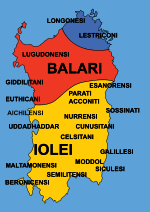
Throughout the second millennium and into the first part of the first millennium BC, Sardinia was inhabited by the single extensive and uniform cultural group represented by the Nuragic people.
Centuries later, Roman sources describe the island as inhabited by numerous tribes which had gradually merged culturally. They however maintained their political identities and the tribes often fought each other for control of the most valuable land. The most important Nuragic populations mentioned include the Balares, the Corsi and the Ilienses, the latter defying the Romanization process and living in what had been called Civitatas Barbarie (now Barbagia).
- The Balares have been identified with the Bonnanaro culture, deriving from the Beaker culture, and were most likely of Indo-European origins. They lived in what are now the Nurra, Coghinas and Limbara traditional subdivisions of Sardinia. They were of the same stock from which the Talaiotic culture of the Balearic Islands originated.
- The Ilienses or Iolaes (later Diagesbes), identified by ancient writers as Greek colonists led by Iolaus (nephew of Heracles) or Trojan refugees, lived in what is now central-southern Sardinia. Greek historians reported also that they were repeatedly invaded by the Carthaginians and the Romans, but in vain.[30]
- The Corsi lived in Gallura and in Corsica. They have been identified as the descendants of the Arzachena culture. In southern Corsica, in the 2nd millennium BC, the Torrean civilization developed alongside the Nuragic one.
Culture
Religion
The representations of animals, such as the bull, belong most likely to pre-Nuragic civilizations, however they kept their importance among the Nuraghe people, and were frequently depicted on ships, bronze vases, used in religious rites. Small bronze sculptures depicting half-man, half-bull figures have been found, as well as characters with four arms and eyes and two-headed deers: they probably had a mythological and religious significance. Another holy animal which was frequently depicted is the dove. Also having a religious role were perhaps the small chiseled discs, with geometrical patterns, known as pintadera, although their function has not been identified yet.
A key element of the Nuragic religion was that of fertility, connected to the male power of the Bull-Sun and the female one of Water-Moon. According to the scholars' studies, there existed a Mediterranean-type Mother Goddess and a God-Father (Babai). An important role was that of mythological heroes such as Norax, Sardus, Iolaos and Aristeus, military leaders considered also as divinities.
The excavations have proved that the Nuragic people, in determinate periods of the year, gathered in common holy places, usually characterized by sitting steps and the presence of a holy pit. In some holy areas, such as Gremanu at Fonni, Serra Orrios at Dorgali and S'Arcu 'e is forros at Villagrande Strisaili, there were rectangular temples, with central holy room housing perhaps a holy fire.[31] The deities worshipped are unknown, but were perhaps connected to water, or to astronomical entities (Sun, Moon, solstices).
Some structures could have a "federal" Sardinian role, such as the sanctuary of Santa Vittoria near Serri, including both religious and civil buildings: here, according to Italian historian Giovanni Lilliu, the main clans of the central island held their assemblies to sign alliances, decide wars or to stipulate commercial agreements.[32] Spaces for trades were also present. At least twenty of such multirole structures are known, including those of Santa Cristina at Paulilatino and of Siligo; some have been re-used as Christian temples (such as the cumbessias of San Salvatore in Sinis at Cabras).
Holy wells
The Holy wells were structures dedicated to the cult of waters. Though initially assigned to the 8th to 6th centuries BC, due to their advanced buildings techniques, they most likely date to the earlier Bronze Age, when Sardinia had strong relationships with the Mycenaean kingdoms of Greece and Crete.
The architecture of the Nuragic Holy wells follows the same pattern as that of the nuraghe, the main part consisting of a circular room with a tholos vault with a hole at the summit. A monumental staircase connected the entrance to this subterranean (hypogeum) room, whose main role is to collect the water of the sacred spring. The exterior walls feature stone benches where offerings and religious objects were placed by the faithful. Some sites also had sacrificial altars. Some scholars think that these could be dedicated to Sardus, one of the main Nuragic divinities.
A sacred pit similar to those of Sardinia has been found in western Bulgaria, near the village of Garlo.[33]
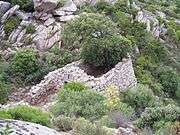
Megaron temples
Located in various parts of the Island and dedicated to the cult of the healthy waters, these unique buildings are an architectural manifestation that reflects the cultural vitality of the nuragic peoples and their interaction with the coeval mediterranean civilizations. In fact, many scholars see in these buildings foreign Aegean influences.[34]
They have a rectilinear form with the side walls that extend outwardly. Some, like that of Malchittu at Arzachena, are apsidal while others such as the temple of Sa Carcaredda at Villagrande Strisaili culminate with a circular room. They are surrounded by sacred precincts called temenos.
The largest and best preserved Sardinian Mégara is that called Sa Domu de Orghìa at Esterzili.
Giant's graves
The so-called "giant's graves" were funerary structures whose precise function is still unknown, and which perhaps evolved from elongated dolmens. They date to the whole Nuragic era up to the Iron Age, and are more frequent in the central sector of the island. Their plan was in the shape of the head of a bull.
Large stone sculptures known as betili (a kind of slender menhir, sometimes featuring crude depiction of male sexual organs, or of female breasts) were erected near the entrance.
Art
Bronze statuettes
The so-called bronzetti (brunzittos or brunzittus in Sardinian language) are small bronze statuettes obtained with the lost-wax casting technique; they can measure up to 39 cm and represent scenes of everyday life, characters from different social classes, animal figures, divinities, ships etc.
Most of them had been discovered in various sites of Sardinia; however, a sizeable minority had also been found in Etruscan sites, particularly tombs, of central Italy (Vulci, Vetulonia, Populonia, Magione) and Campania (Pontecagnano) and further south in the greek colony of Crotone.

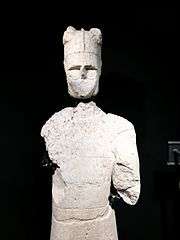
Giants of Mont'e Prama
The Giants of Mont'e Prama are a group of 32 (or 40) statues with a height of up to 2.5 m, found in 1974 near Cabras, in the province of Oristano. They depict warriors, archers, wrestlers, models of nuraghe and boxers with shield and armed glove. They date to around the 10th to 8th centuries BC.
They feature disc-shaped eyes and eastern-like garments. The statues probably depicted mythological heroes, guarding a sepulchre; according to another theory, they could be a sort of Pantheon of the typical Nuragic divinities.
Their finding proved that the Nuragic civilization had maintained its peculiarities, and introduced new ones across the centuries, well into the Phoenician colonization of part of Sardinia.
Language
The language (or the languages) spoken in Sardinia during the Bronze Age is unknown since there are no written records of that period, although recent researchs suggest that around the 8th century BC, in the Iron Age, the Nuragic populations may have adopted an alphabet similar to that used in Euboea.[35]
According to Eduardo Blasco Ferrer the Proto-Sardinian language was akin to Proto-Basque and the ancient Iberian with faint Indoeuropean traces,[36] while others believe it was related to Etruscan. Some scholars theorize that there were actually various linguistic areas (two or more) in Nuragic Sardinia, possibly Pre-Indoeuropeans and Indoeuropeans.[37]
Economy
The Nuragic economy, at least at the origins, was mostly based on agriculture (new studies suggest that they were the first to practice viticulture in the western Mediterranean[38]) and animal husbandry, as well as on fishing.[39] As in modern Sardinia, 60% of the soil was suitable only for breeding cattle and sheep. Probably, as in other human communities that have the cattle as traditional economic base, the property of this established social hierarchies.
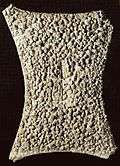
Navigation had an important role: historian Pierluigi Montalbano mentions the finding of nuragic anchors along the coast, some weighing 100 kg.[39] This has suggested that the Nuragic people used efficient ships, which could perhaps reach lengths up to 15 meters. These allowed them to travel the whole Mediterranean, establishing commercial links with the Mycenaean civilization (attested by the common tholos tomb shape, and the adoration of bulls), Spain, Italy, Cyprus, Lebanon. Items such as Cyprus-type copper ingots have been found in Sardinia, while bronze and early Iron Age Nuragic ceramics have been found in the Aegean region, in Spain (Huelva, Tarragona, Málaga, Teruel and Cádiz)[40] up to the Gibraltar strait, and in Etruscan centers of the Italian peninsula such as Vetulonia, Vulci and Populonia (known in the 9th to 6th centuries from Nuragic statues found in their tombs).
_33.jpg)
Sardinia was rich in metals such as lead and copper. Archaeological findings have proven the good quality of Nuragic metallurgy, including numerous bronze weapons. The so-called "golden age" of the Nuragic civilization (late 2nd millennium BC, early 1st millennium BC) coincided perhaps with the apex of the mining of metals in the island.
The widespread use of bronze, an alloy which used tin, a metal which however was not present in Sardinia if not in a single deposit, further proves the capability of the Nuragic people to trade in the resources they needed. A recent study (2013) of 71 ancient Swedish bronze objects dated to Nordic Bronze Age, revealed that most of copper utilized at that time in Scandinavia came from Sardinia and the Iberian peninsula.[41]
See also
- Nuraghe
- History of Sardinia
- List of Nuragic tribes
- Paleo-Sardinian language
- Ancient peoples of Italy
- Prehistoric Italy
Notes
- ↑ Giovanni Lilliu, Sardegna Nuragica, (Edizioni Maestrali) 2006
- ↑ There is no complete census, but the figure of 7,000 in E. Contu, "L'architettura nuraghica", in E. Atzeni et al., Ichnussa, 1985:5, is often repeated, and 'the Provincia di Cagliari website, estimatesmore than 7,000.
- ↑ Parole di segni, L'alba della scrittura in Sardegna, Sardegna archeologica, Guide e Itinerari, M.Monoja, C.Cossu, M.Migaleddu, Carlo Delfino Editore, Sassari, 2012
- ↑ La Sardegna nelle fonti classiche, M.Perra, S'Alvure editrice, Oristano, 1993
- ↑ Luca Lai (2008). The Interplay of Economic, Climatic and Cultural Change Investigated Through Isotopic Analyses of Bone Tissue: The Case of Sardinia 4000--1900 BC. ProQuest. p. 119. ISBN 978-0-549-77286-6.
- ↑ Ercole Contu, Sardegna Archeologica – L'Altare preistorico di Monte D'Accoddi, p. 65
- ↑ Giovanni Lilliu, Arte e religione della Sardegna prenuragica, p.132
- ↑ Alberto Moravetti, il complesso nuragico di Palmavera
- ↑ Paolo Melis, I rapporti fra la Sardegna settentrionale e la Corsica nell’antica età del Bronzo
- ↑ Lilliu 2004, p. 362.
- ↑ Lilliu 1982, p. 25-26-27.
- 1 2 Lilliu 1982, p. 9.
- ↑ The strict patterning in the landscape of tombs and nuraghes was analyzed by Emma Blake, "Constructing a Nuragic Locale: The Spatial Relationship between Tombs and Towers in Bronze Age Sardinia" American Journal of Archaeology 105.2 (April 2001:145-161).
- ↑ Sardegna Nuragica by Giovanni Lilliu
- ↑ Francesco Cesare Casula, aBreve storia di Sardegna, p. 25. ISBN 88-7138-065-7
- ↑ "provinciadelsole.it". Retrieved 3 May 2015.
- ↑ Tin as a draw for traders was first suggested in the essay on Sardinian metallurgy by N. Gale and Z, Gale in Miriam S. Balmuth, ed. Studies in Sardinian Archaeology 3 (Oxford, 1987).
- ↑ R.F. Tylecote, M.S. Balmuth, R. Massoli-Novelli, "Copper and Bronze Metallurgy in Sardinia", Historia Metallica 17.2, (1983:63–77).
- ↑ Miriam S. Balmuth, ed. Studies in Sardinian Archaeology 3: Nuragic Sardinia and the Mycenaean World (Oxford, 1987) presents papers from a colloquium in Rome, September 1986; the view of "gateway-communities" from the Mycenaean direction is explored in T.R. Smith, Mycenaean Trade and Interaction in the West Central Mediterranean, 1600-100 B.C., 1987.
- ↑ "SP INTERVISTA>GIOVANNI UGAS: SHARDANA". Retrieved 3 May 2015.
- ↑ Pallottino 2000, p. 119.
- ↑ Paola Ruggeri - Talos, l'automa bronzeo contro i Sardi: le relazioni più antiche tra Creta e la Sardegna
- ↑ Ceramiche. Storia, linguaggio e prospettive in Sardegna - pg.34
- ↑ Gale, N.H. 2011. ‘Source of the Lead Metal used to make a Repair Clamp on a Nuragic Vase recently excavated at Pyla-Kokkinokremos on Cyprus’. In V. Karageorghis and O. Kouka (eds.), On Cooking Pots, Drinking Cups, Loomweights and Ethnicity in Bronze Age Cyprus and Neighbouring Regions, Nicosia.
- ↑ Santoni, Vincenzo; Sabatini, Donatella (2010) Gonnesa, Nuraghe Serucci. IX Campagna di scavo 2007/2008. Relazione e analisi preliminare.
- ↑ " Long time archaeological riddle solved, Canaanite general was based in Wadi Ara, Judy Siegel-Itzkovich, 07/02/2010, Jerusalem Post.
- ↑ Carlo Tronchetti. "Quali aristocrazie nella Sardegna dell'età del Ferro? in Istituto Italiano di Preistoria e Protostoria. Atti della XLIV Riunione Scientifica. La Preistoria e la Protostoria della Sardegna, Firenze 2012, pp. 851-856". Retrieved 3 May 2015.
- ↑ Paolo Bernardini-Necropoli della Prima Età del Ferroin Sardegna. Una riflessione su alcuni secoli perdutio, meglio, perduti di vista (2011)
- ↑ Ugas 2005, p. 241.
- ↑ Pausanias, IX, 17, 5.
- ↑ Giovanni Lilliu, Arte e religione della Sardegna nuragica
- ↑ Lilliu, Giovanni. "Al tempo dei nuraghi". La civiltà in Sardegna nei secoli. p. 22.
- ↑ Mitova - Dzonova , D.,; Megalithischer Brunnentempel protosardinischen Typs vom Dorf Garlo, Bez. Pernik; Sofia: Komitee fur Kultur, 1983
- ↑ Lilliu 1982, p. 109.
- ↑ Giovanni Ugas, I segni numerali e di scrittura in Sardegna tra l’Età del Bronzo e il i Ferro, In: Tharros Felix 5, a cura di Attilio Mastino, Pier Giorgio Spanu, Raimondo Zucca. Roma : Carocci, 2013, pp. 295-377
- ↑ Eduardo Blasco Ferrer, ed. 2010. Paleosardo: Le radici linguistiche della Sardegna neolitica (Paleosardo: The Linguistic Roots of Neolithic Sardinian). De Gruyter Mouton
- ↑ Giovanni Ugas - L'Alba dei Nuraghi pg.241,254 - Cagliari, 2005
- ↑ Unica.it, È in Sardegna il più antico vitigno del Mediterraneo occidentale
- 1 2 Montalbano, Pierluigi (July 2009). SHRDN, Signori del mare e del metallo. Nuoro: Zenia. ISBN 978-88-904157-1-5.
- ↑ Giovanna Fundoni. "Le ceramiche nuragiche nella Penisola Iberica e le relazioni tra la Sardegna e la Penisola Iberica nei primi secoli del I millennio a.C.". Retrieved 3 May 2015.
- ↑ "Moving metals II: provenancing Scandinavian Bronze Age artefacts by lead isotope and elemental analyses". Retrieved 3 May 2015.
References
- A Prehistory of Sardinia 2300-500BC (Monographs in Mediterranean Archaeology), (1996), G.S.Webster, Sheffield Academic Press, ISBN 978-1850755081
- Atzeni Enrico (1981). Ichnussa. La Sardegna dalle origini all'età classica. Milan.
- AA.VV (1967). La civiltà in Sardegna nei secoli. Turin: ERI.
- Bernardini, Paolo (2010). Le torri, i metalli, il mare. Sassari: Carlo Delfino Editore.
- Depalmas, Anna (2005). Le navicelle di bronzo della Sardegna nuragica. Cagliari: Gasperini.
- Dyson Stephen L., Rowland Robert J. (2007). Shepherds, sailors, & conquerors - Archeology and History in Sardinia from the Stone Age to the Middle Ages. Philadelphia: University of Pennsylvania, Museum of Archeology and Anthropology. ISBN 978-1-934536-02-5.
- Foddai, Lavinia (2008). Sculture zoomorfe. Studi sulla bronzistica figurata nuragica. Cargeghe: Biblioteca di Sardegna.
- Laner, Franco (2011). Sardegna preistorica, dagli antropomorfi ai telamoni di Monte Prama, Sa 'ENA. Cagliari: Condaghes.
- Lilliu, Giovanni (1966). Sculture della Sardegna nuragica. Cagliari: La Zattera. Book on line from Sardegnadigitallibrary.it ed. 2008 Illisso
- Lilliu, Giovanni (2004). La civiltà dei Sardi dal paleolitico all'età dei nuraghi. Nuoro: Il Maestrale.
- Lilliu, Giovanni (1982). La Civiltà Nuragica. Sassari: Delfino. Book on line from Sardegnadigiltallibrary.it
- Lilliu, Giovanni (2006). Sardegna Nuragica. Nuoro: Edizioni Il Maestrale. ISBN 88-89801-11-5. Book on line from Sardegnadigitallibrary.it
- Melis, Paolo (2003). Civiltà nuragica. Sassari: Delfino Editore.
- Montalbano, Pierluigi (July 2009). SHRDN, Signori del mare e del metallo. Nuoro: Zenia editrice. ISBN 978-88-904157-1-5.
- Navarro i Barba, Gustau (2010). La Cultura Nuràgica de Sardenya. Barcelona: Edicions dels A.L.I.LL. ISBN 978-84-613-9278-0.
- Pallottino, Massimo (2000). La Sardegna nuragica. Nuoro: edizioni Ilisso. ISBN 88-87825-10-6.
- Perra, Mario (1997). ΣΑΡΔΩ, Sardinia, Sardegna (3 Volumes). Oristano: S'Alvure.
- Pittau, Massimo (2001). La lingua sardiana o dei protosardi. Cagliari: Ettore Gasperini editore.
- Pittau, Massimo (2007). Storia dei sardi nuragici. Selargius: Domus de Janas editrice.
- Pittau, Massimo (2008). Il Sardus Pater e i Guerrieri di Monte Prama. Sassari: EDES.
- Pittau, Massimo (2011). Gli antichi sardi fra I "Popoli del mare". Selargius: Domus de Janas editrice.
- Pittau, Massimo (2013). La Sardegna nuragica. Cagliari: Edizioni della Torre.
- Scintu, Danilo (2003). Le Torri del cielo, Architettura e simbolismo dei nuraghi di Sardegna. Mogoro: PTM editrice.
- Ugas, Giovanni (2005). L'Alba dei Nuraghi. Cagliari: Fabula editrice. ISBN 88-89661-00-3.
- Vacca, E.B. (1994). La civiltà nuragica e il mare. Quartu Sant'Elena: ASRA editrice.
